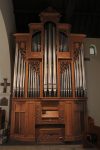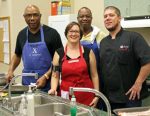A New Way
“School days, school days, dear old Golden Rule days …”
If you remember that old song it means you’re, well, old! It also means you can recall when the front of your school classroom featured a big blackboard on which all of your assignments for reading, writing and ʼrithmetic were carefully inscribed by your teacher with sticks of calcium sulfate or calcium carbonate, better known as chalk.
In fact, you might’ve been the good kid who got the special privilege of cleaning the erasers by banging them together. On occasion, I had that privilege in my school. It meant that you got to go outside and breathe the sweet air of outdoor freedom after having been imprisoned in the same classroom for the previous six hours.
Or maybe you were the bad kid who got after-school detention and had to wipe down the whole board with a damp cloth. Whether you approached it for praise or punishment, or to work out that difficult math problem in front of the whole class, the blackboard was the nerve center of classroom life.
It still is to some degree, although kids today will never know the smell of a cloud of chalk. Instead, they get the alcohol smell of the markers for the dry-erase board, which started to phase out the blackboard in the late 1980s. Actually, the blackboard’s demise started a little earlier than that with the advent of the green chalkboard, which was made from steel and porcelain and was less fragile than the older, heavier, slate boards. The green color was also supposed to be easier on the eyes, and the chalk powder didn’t show up as much, making it easier for the Bart Simpson-esque class clown to wipe it down after school.
The evolution of the classroom board continues today as some schools have “smartboards” that allow what’s handwritten on them to be immediately photographed, digitized and downloaded — no need for copying down your homework.
You might think of the blackboard as ancient technology, but the truth is that since civilization began in Mesopotamia, people have been scribbling on things, and then correcting their mistakes. The Akkadians and Babylonians used wet clay tablets and a stylus for writing, the marks of which were easily erased unless you wanted to bake the clay and make them permanent. The Romans used wax tablets that could be warmed and reformed as a kind of early Etch A Sketch. In Latin, tabula rasa means “clean slate.”
Of course, if you want something to be permanently written, you “write it in stone.” The first real document we encounter in the Bible is written that way, the Ten Commandments being chiseled on stone tablets when Moses was in conference with God on Mount Sinai. The Israelites carried those tablets around in the Ark of the Covenant for generations until the Ark itself rested in Solomon’s Temple.
In Jeremiah’s day, however, those stone tablets were gone. They disappeared sometime during the Babylonian invasion of Judah and the subsequent exile of God’s people to Babylon around 586 BC. Whether they wound up in a forgotten hiding place, were destroyed or are languishing in a warehouse in New Jersey, nobody really knows.
What we do know is that the exile was a major event in the history of God’s people, destroying the world as they knew it and leaving them with an uncertain future. How were they to move forward now that the covenant with God had been broken by their sin? What was to guide them when the tablets were no longer around to give them the rules? How would they now relate to God on the other side of exile?
Many people thought that God’s judgment had been harsh and that they had suffered for the sins of their parents (v. 29). God, however, reminds them that from now on they will be responsible for their own sins and their “teeth will be set on edge” when they deal with those sins, like what happens in our bones when fingernails are scraped across a blackboard (v. 30).
But God won’t leave the people to suffer endlessly for those sins. Whereas the old Sinai covenant was chiseled in stone and offered no practical means, other than endless animal sacrifices to erase the sins they committed, God promised the returning exiles a new covenant. God would write this covenant on their hearts — a “heartboard” that could be repeatedly erased, cleaned and made new.
“I will put my law within them,” said God through Jeremiah, “and I will write it on their hearts; and I will be their God, and they shall be my people” (v. 33). In an elementary school classroom, you might expect the rules to be framed and hung on the wall for all to see, and if you violated them, you might be required to write them 25 times on the chalkboard, whiteboard or smartboard as a punishment. Whether that punishment is effective, however, depends on the orientation of the child. No amount of scribal repetition will change the hard heart of a rebellious child.
In a high school classroom, on the other hand, you’re less likely to see the rules scribbled out on the wall. Instead, those rules should already be internalized by people old enough to have the capacity to know what’s right.
The same is true for God’s people. Knowing the commandments and obeying them are two separate things. To obey freely, one must have an inward sense of what’s right and wrong, an inward orientation to please the one in authority, and a desire for repentance and forgiveness.
God’s people had spent 70 years in exile. It was akin to a timeout — plenty of time to figure out what they had done wrong. Going forward, God now expected them to relate to him in a different way — not as coerced, chastised children, but as people on the way to maturity. Repentance and forgiveness were the means by which God would work in his people, forming them into a covenant community based not on external compulsion but on internal communion with God.
No longer will they need those stone tablets or endless, repetitive instructions about who God is. Instead, they will know God by God’s grace, by God’s forgiveness, by what God does in their hearts. And what is God doing there? Erasing the brokenness. “For I will forgive their iniquity,” says the Lord, “and remember their sins no more” (v. 34).
In other words, their “heartboards” could be cleaned and renewed.
And in the ultimate reversal, they wouldn’t have to clean those boards on their own as a constant punishment. Instead, someone was coming who would take their punishment on himself and enable their hearts to be washed clean of their sin forever. The writer of Hebrews describes this as the mission of Jesus, who “has now obtained a more excellent ministry, and to that degree he is the mediator of a better covenant … In speaking of a new covenant, he has made the first one obsolete” (Hebrews 8:6, 13).
As Jesus embodied the new covenant, we who are his people by his grace are made new, our sins erased and our lives given a tabula rasa.
What’s inscribed on your heartboard? Maybe it’s a problem from the past, something you can’t shake, a fear or shame that binds you and keeps you in exile from God. Here’s the good news: God is ready to wipe your life clean through the grace of his Son, Jesus Christ.
No need to pound the erasers.
 St. Andrew’s Episcopal Church was established in Tampa in 1871. Its first service was held in the hospital building at Fort Brooke. A wooden church was erected in 1883 on the city block bounded by Marion, Twiggs, Morgan, and Madison.
St. Andrew’s Episcopal Church was established in Tampa in 1871. Its first service was held in the hospital building at Fort Brooke. A wooden church was erected in 1883 on the city block bounded by Marion, Twiggs, Morgan, and Madison. This history of the Windows of Saint Andrew’s is based upon research by the late Laban G. Lively. Additional information has been added by Nancy Turner. It is reconstructed for presentation on the WWW by Joe Daurril. Photos taken by Chris Cobb.
This history of the Windows of Saint Andrew’s is based upon research by the late Laban G. Lively. Additional information has been added by Nancy Turner. It is reconstructed for presentation on the WWW by Joe Daurril. Photos taken by Chris Cobb. The organ at St. Andrew’s Episcopal Church, Tampa, Florida, was designed and built by C. B. Fisk, Inc., of Gloucester, Massachusetts.
The organ at St. Andrew’s Episcopal Church, Tampa, Florida, was designed and built by C. B. Fisk, Inc., of Gloucester, Massachusetts. Ministry at St. Andrew’s is an integral part of our parish life and our community.
Ministry at St. Andrew’s is an integral part of our parish life and our community. St. Andrew's seeks to ensure that we are meeting the spiritual and religious education needs of all our members.
St. Andrew's seeks to ensure that we are meeting the spiritual and religious education needs of all our members.

 St. Andrew’s Episcopal Church was established in Tampa in 1871. Its first service was held in the hospital building at Fort Brooke. A wooden church was erected in 1883 on the city block bounded by Marion, Twiggs, Morgan, and Madison.
St. Andrew’s Episcopal Church was established in Tampa in 1871. Its first service was held in the hospital building at Fort Brooke. A wooden church was erected in 1883 on the city block bounded by Marion, Twiggs, Morgan, and Madison. This history of the Windows of Saint Andrew’s is based upon research by the late Laban G. Lively. Additional information has been added by Nancy Turner. It is reconstructed for presentation on the WWW by Joe Daurril. Photos taken by Chris Cobb.
This history of the Windows of Saint Andrew’s is based upon research by the late Laban G. Lively. Additional information has been added by Nancy Turner. It is reconstructed for presentation on the WWW by Joe Daurril. Photos taken by Chris Cobb.
 The organ at St. Andrew’s Episcopal Church, Tampa, Florida, was designed and built by C. B. Fisk, Inc., of Gloucester, Massachusetts.
The organ at St. Andrew’s Episcopal Church, Tampa, Florida, was designed and built by C. B. Fisk, Inc., of Gloucester, Massachusetts. Ministry at St. Andrew’s is an integral part of our parish life and our community.
Ministry at St. Andrew’s is an integral part of our parish life and our community. St. Andrew's seeks to ensure that we are meeting the spiritual and religious education needs of all our members.
St. Andrew's seeks to ensure that we are meeting the spiritual and religious education needs of all our members.